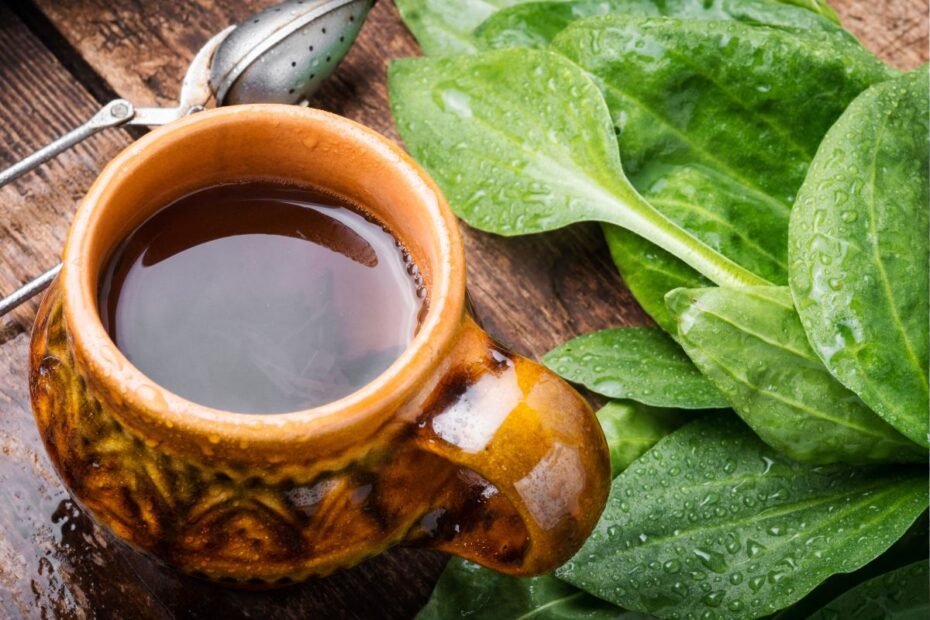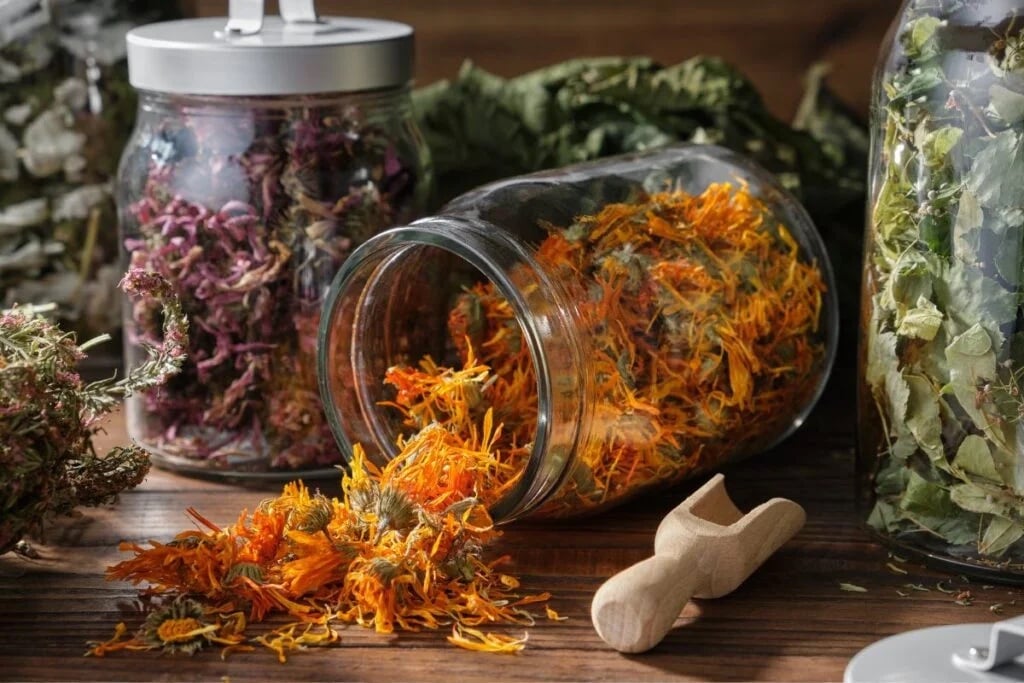Wherever you go—on a meadow path, in your grandmother’s backyard, or by the side of the road—you’ll find plantains everywhere. This plant is so widespread as a weed that everybody has probably seen and known it. However, it may be a ‘friend’ to human health. Plantain tea can be effective in disease treatment. In summary, plantain tea benefits consist of three main healing properties, which we discuss.
Plantain: Let’s Get to Know It Better
Plantains originate from the European continent, where they grow widely. In Anglo-Saxon mythology, plantain is one of the nine herbs considered sacred. They have been described as medicinal plants since the 11th and 12th centuries. Native Americans called the plant ‘white man’s foot’ because plantain is one of the few plants that Europeans brought to the New World, not the other way around.
There are about 250 known species of plantains. 4 species of plantain grow naturally in Europe: broadleaf plantain (Plantago major), ribwort plantain (Plantago lanseolata), hoary plantain (Plantago media), and branched plantain (Plantago arenaria).
All the species mentioned have similarities and slight differences in appearance. Broadleaf, ribwort, and hoary plantains have leaves arranged in a scarlet pattern and bloom in bell-shaped inflorescences situated on a long stem. The leaves of these plantain species differ: the first has broad, oval leaves, the second has lanceolate leaves, and the hoary plantain has elliptic leaves. The leaves of all types of plantains are bright green, thick, and veined. While the appearance of the branched plantain differs, it resembles a low, sparse shrub with spiny leaves and ellipse-shaped flowers.
The plantain has some other folk names that describe its beneficial properties: psyllium and fleaworts.

The Medicinal Raw Material of Plantains Tea
The most common species for plantain tea are broadleaf and ribwort plantains. You may buy plantain raw materials in pharmacies or specialized shops. However, it is not difficult to collect them yourself, as they grow nearby.
Let’s harvest plantain leaves when the plants bloom in June and September. Repeat collections before the first frost.
The recommendations say to harvest leaves with 5 cm of petioles. Arrange the leaves in a single layer and dry them in a well-ventilated room protected from sunlight. During the drying process, flip over the leaves occasionally.
When the petioles become crispy, the leaves twist into a spiral, giving off a faint scent, so the plantain medicinal raw material is ready. The good-quality dry leaves should remain green with a slightly bitter taste.
Store dried plantain leaf raw material in airtight containers in a dark, dry place.
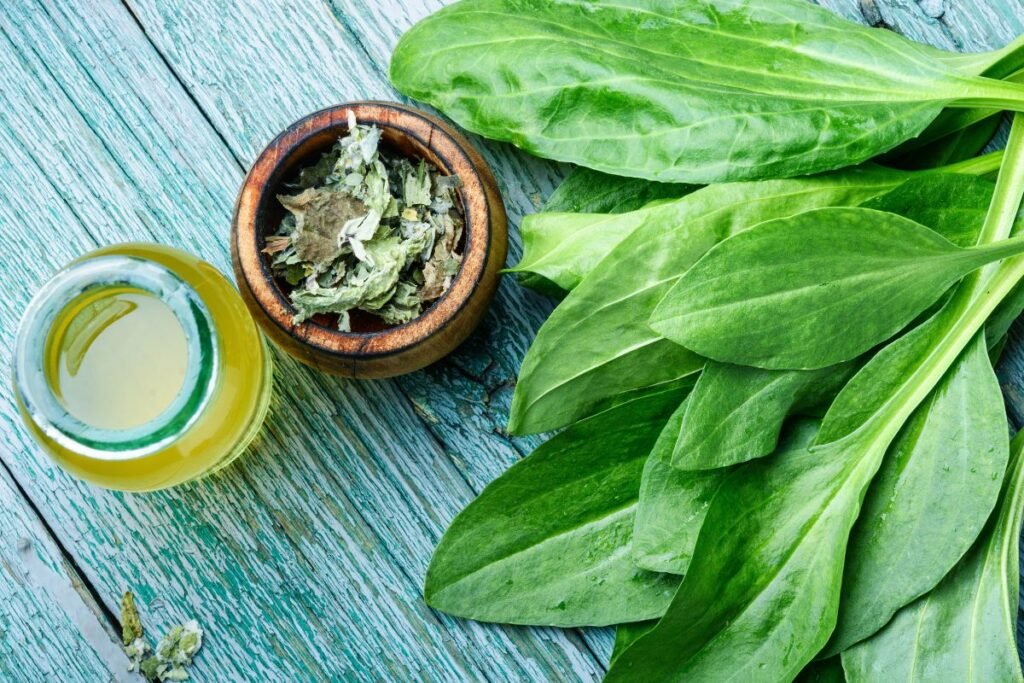
Benefits of Plantain Tea and Leaves
Plantain leaves have a nutritional composition that is highly beneficial to health. They contain several anti-inflammatory compounds, including flavonoids, terpenoids, glycosides, and tannins. Consequently, plantain leaves have antiseptic and anti-inflammatory properties.
People use plantain leaves as food and medicine. You may eat them fresh or cooked, made into tea, juiced, and used externally. In all cases, the benefits of plantains are equally effective for the body.
There are three main properties of the health effects of plantains:
Plantain Fights Inflammation
This plant treats lung diseases. Plantain tea has long been used in folk medicine to treat coughs, relieve expectoration, and decongest bronchial secretions.
In vitro studies have shown that plantain extract reduces markers of inflammation caused by liver damage several times. These studies also suggest that plantains may be effective in cancer prevention. The potential of the plant is still being investigated.

Plantain Heals and Disinfects Wounds and Stops Bleeding
Did you put a plantain leaf on a wound to stop bleeding? Probably, you may have experienced this property in childhood for scrapes, cuts, etc.
Clinical trials also confirmed these properties of plantains. It has been found that plantain leaves can help heal wounds, reduce inflammation, block microbial growth, and relieve pain. This is why therapeutic skin ointments and mouthwashes to treat oral mucosa and throat diseases add plantain leaf extracts.
Plantain Tea Maintain Digestive Health
Plantain leaf tea improves digestion, helps with constipation, and enhances appetite. These teas treat stomach ulcers.
Animal studies show that plantains’s anti-inflammatory properties can help treat intestinal inflammation and reduce unpleasant symptoms such as stomach pain, bloating, and diarrhea.
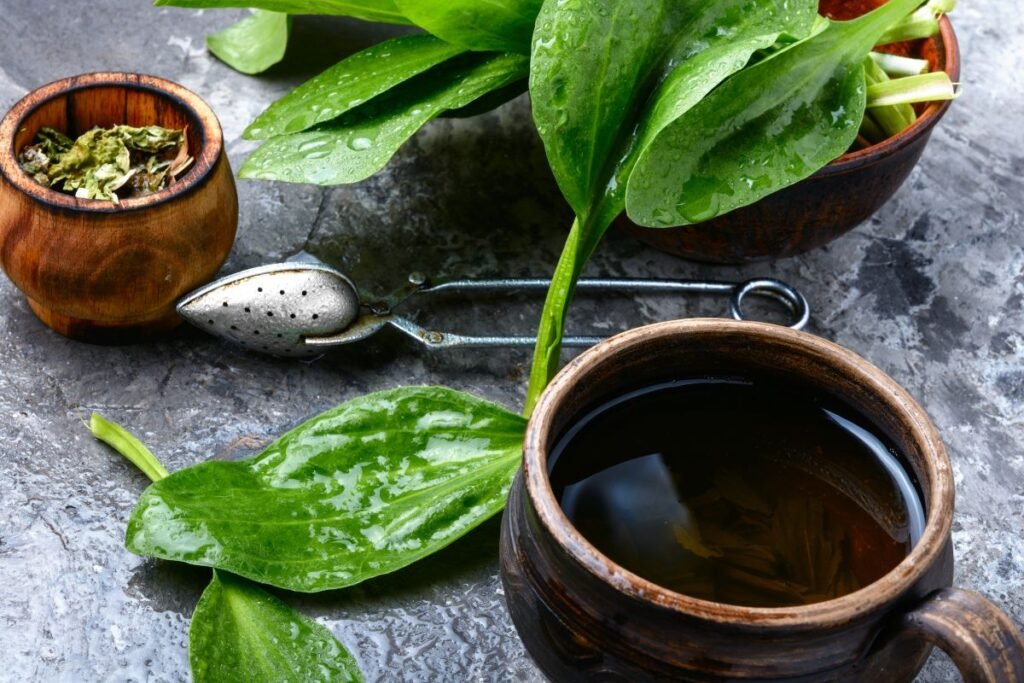
Plantain Tea from Leaves
You can make healing plantain tea from leaves alone or combined with other herbs, such as calendula. This tea usually requires dried plantain leaves. You can use fresh plantain leaves for mouth rinses and wound washes.
To prepare plantain leaf tea, you need:
- 1 tablespoon of dried plantain leaves
- 200 ml of water
Cover the plantain leaves with boiling water, cover, and soak for 10–15 minutes. After this time, strain the tea and drink. If you prefer, you can sweeten the tea with honey or another natural sweetener.
Drink one cup of the tea 2-3 times a day for therapeutic purposes.
The infusion consists of 2-3 tablespoons of 200 ml of water and chopped fresh plantain leaves.
Plantain Leaves in The Diet
Plantain is a highly nutritious plant, so enriching your daily diet with plantain leaves is easy. Its leaves are rich in calcium, vitamins A, C, and K, as well as many other valuable substances. From spring until the first frost, we can pick up this vitamin- and mineral-rich plant right in our backyard. How do I use it? Here are some ideas:
- Try to eat young and fresh plantain leaves. Add them to salads and sandwiches, or nibble on them as a snack.
- Stew older, mature plantain leaves. Add them to stews and soups.
- Make a juice or green smoothies of plantain leaves.
- Try to use dried and crushed plantain leaves as a spice for dish seasoning. Add them together with other herbs.
- Dress the plantain leaves with a high-quality oil of your choice (sunflower, olive, almond, etc.). Use this oil as a salad dressing or externally to treat the skin on your hands.
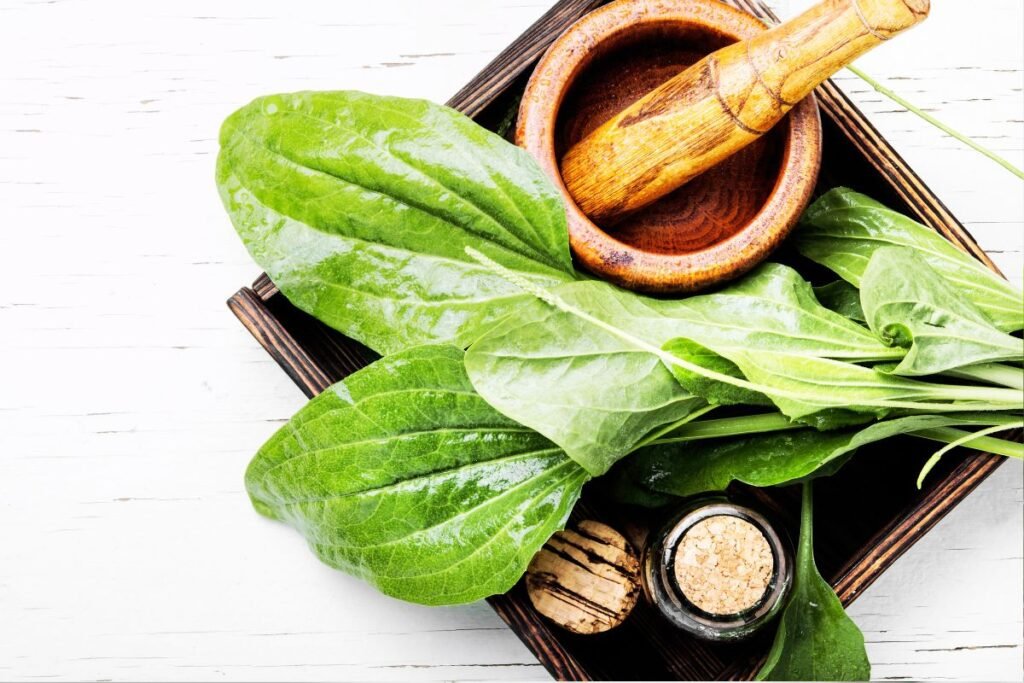
Green Plantain Leaf Juice
This green juice, full of minerals and vitamins, is an excellent way to start the day! You can make this drink from plantains alone or mix it with herbs such as dill to give it a detoxifying energy boost. Use the recipe below to make two servings of juice.
Ingredients:
- 2 cups fresh plantain leaves
- 3 cups of water
Place the plantain leaves in a blender, cover with water, and puree for 1-2 minutes.
Strain the prepared juice to remove the fibrous plant material. Use it for compost, or reuse it for making homemade beauty products, etc.
Serve the juice in a glass. If you want to freshen up, you can add ice.
Plantain leaf juice compresses are perfect for applying to bruises and wounds.
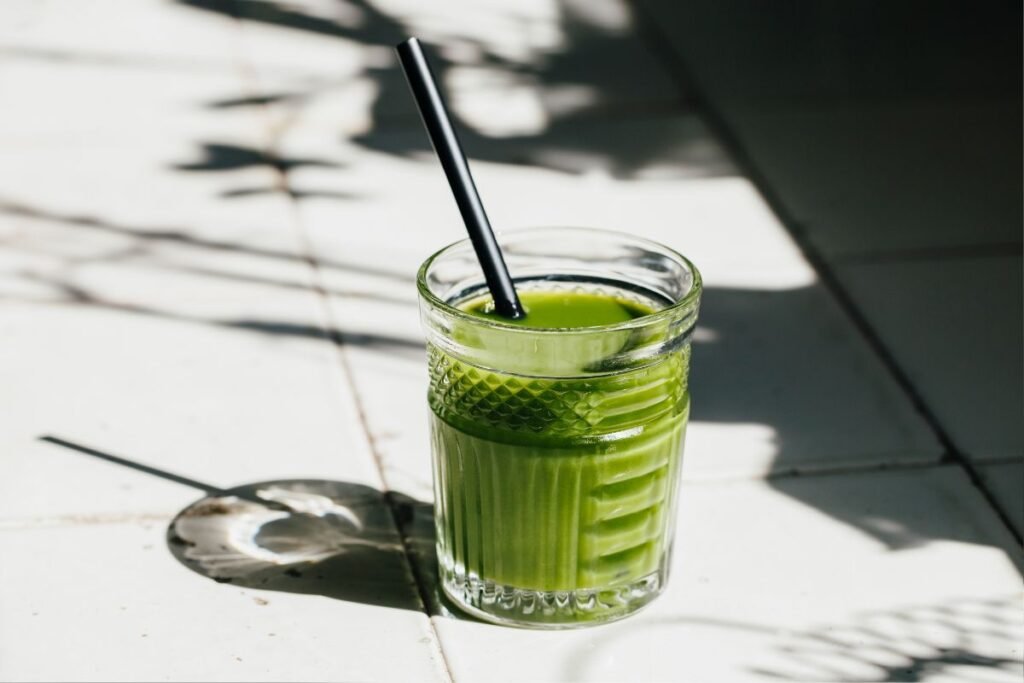
Plantain Leaves for Skin Beauty and Health
You can add crushed plantain leaves, either fresh or dried to a variety of homemade cosmetics, such as creams, lotions, masks, balms, etc.
Plantain is very useful for treating skin problems such as acne or eczema. A nourishing and healing plantain leaf mask can be made at home. It is particularly recommended if you have previously made plantain leaf juice from leftover fibrous leaf material. Imagine how happy your body would be to be indulged with a healthy drink in the morning and a relaxing and skin-loving treatment in the evening!
Plantain masks are made of crushed pulp of the plantain leaves. Use all that is left over from making the juice. Alternatively, freshly crush 2 cups of plantain leaves. Apply the plantain leaf puree liberally, in a thick layer, to your washed and dried face. Leave on for 10–15 minutes. After this time, rinse your face with warm water and gently pat it dry.
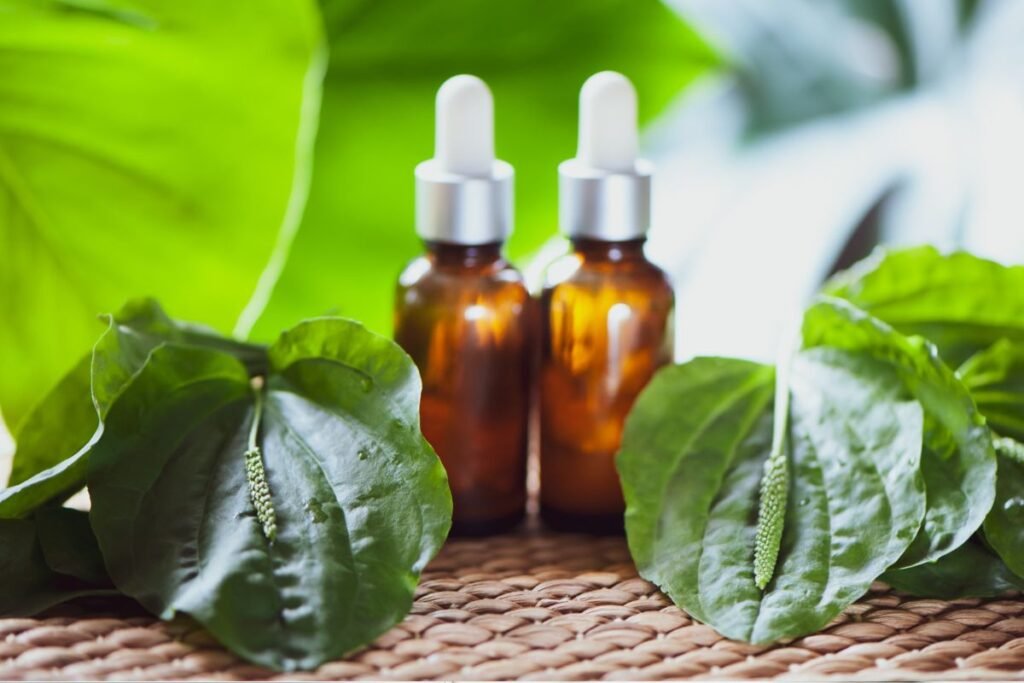
Side Effects of Plantain Tea and Juice
Plantain is one of those plants that is absolutely safe to consume. Of course, it is perfectly safe for those with no side health problems or other possible contraindications.
Only in exceptional cases can plantain leaf tea cause side effects, most likely in the case of an overdose of tea. This can lead to nausea, vomiting, bloating, and diarrhea. Extremely high doses can cause more serious side effects in some cases, including anaphylaxis, a severe and potentially life-threatening allergic reaction.
When taken externally, plantain leaf tea can cause skin allergic reactions in rare cases. Stop using plantain immediately and seek medical advice, if such a reaction occurs.
Plantain leaf juice should not be used in cases of increased gastric acidity.
If you have never taken plantain leaf tea, start with a small amount and monitor for any side effects. Apply a small amount first and wait 24 hours to ensure you are not allergic while taking it externally.
If you are doubtful whether plantain leaf tea is healthy, consult your doctor.
Sources:
- https://www.healthline.com/nutrition/plantain-weed
- https://www.ncbi.nlm.nih.gov/pmc/articles/PMC4537734/
- https://www.ncbi.nlm.nih.gov/pmc/articles/PMC2861812/
- https://pubmed.ncbi.nlm.nih.gov/28839362/
- https://pubmed.ncbi.nlm.nih.gov/29575942/
- https://pubmed.ncbi.nlm.nih.gov/23354396/
- https://www.medicinenet.com/can_you_eat_plantain_weeds_health_benefits_uses/article.htm
- https://theherbalacademy.com/plantain-leaf-benefits-recipes/
- https://mommypotamus.com/plantain/
Associative photos from © Canva.
